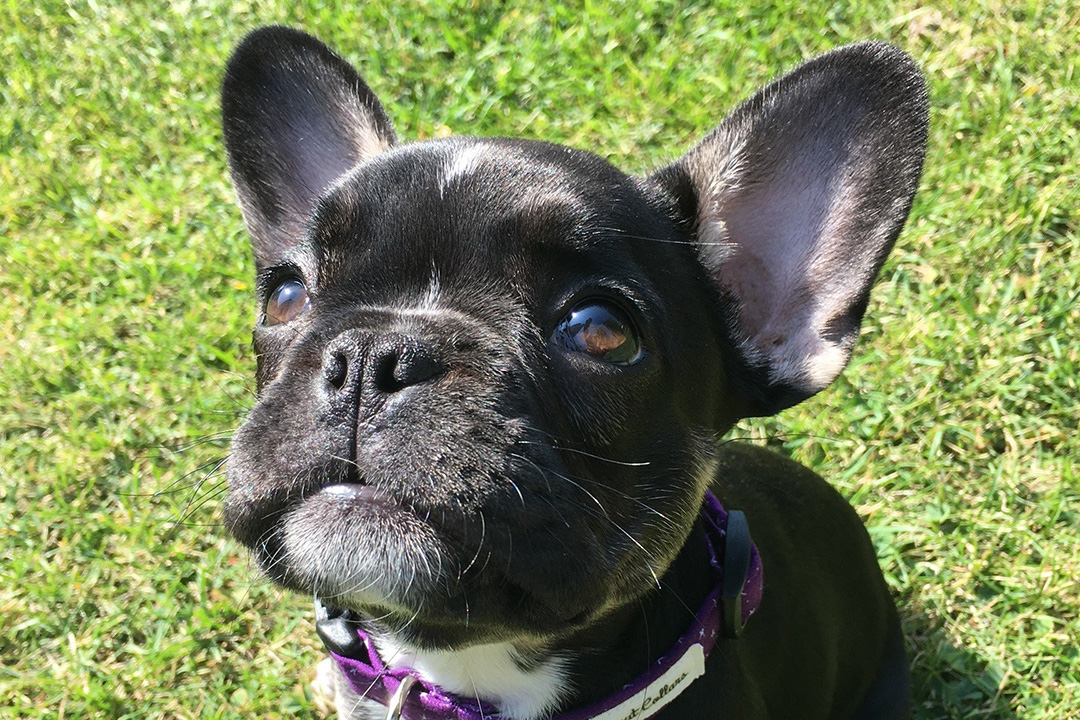
Saving Ooma Girl
When Allan and Maureen Zaleski arrived at the Western College of Veterinary Medicine (WCVM) at 2 a.m. one morning in July 2021, they were ready to do whatever it took to save their dog.
By Jeanette NeufeldThe couple, both in their late 70s, had driven all night from Winnipeg, Man., to seek surgery for Ooma Girl, their three-year-old French bulldog. During the previous evening, Ooma had begun crying loudly with pain in their backyard.
“She was just squealing in pain. I couldn’t believe it,” says Maureen.
Their regular veterinarian, WCVM alumna Dr. Betty Hughes (DVM’77), told them Ooma would need surgery and referred them to the WCVM’s Veterinary Medical Centre (VMC) in a hurry.
“We didn’t want to hesitate because we love her so much,” says Maureen. “Faced with whatever we had to do, we wanted our dog in good health again.”
The couple packed their vehicle, found caregivers for their three small parrots and Isabelle, a 14-year-old pekinese, then began the 780-kilometre trip to Saskatoon.
The Zaleskis say Ooma was clearly in extreme pain during the drive, restricted to her kennel so she wouldn’t further injure herself. The couple got lost on their way into the city and eventually flagged over a taxi driver who led them to the WCVM’s veterinary teaching hospital.
When the Zaleskis arrived, WCVM staff brought Ooma into the hospital and began managing her pain while the couple went to wait at a nearby hotel. The next morning, results of a CT scan confirmed the diagnosis of intervertebral disc disease. One of the discs within the little dog’s vertebral column (spine) had degenerated and displaced. The displaced disc was compressing her spinal cord and causing pain and paralysis.
VMC surgeons performed a hemilaminectomy, which involves drilling a window into the bony vertebral column to access the canal that houses the spinal cord. The window allows surgeons to remove the disc material pinching the spinal cord, explains Dr. Kaustubh Dongaonkar, the small animal surgical resident who conducted Ooma’s surgery.
The procedure is considered a major surgery and can take up to two and a half hours. Ooma recovered well from anesthesia and came out of surgery successfully.
“Prior to her discharge, she was able to stand and walk and bear some weight on both her hind limbs. She bounced back quite quickly,” says Dongaonkar.
This type of surgery is quite common at the VMC — Dongaonkar says the hospital’s surgical team typically performs up to four of these procedures per month. Small breed dogs most commonly experience this condition. According to the most recent literature on this condition, French bulldogs experience recurrence more commonly than other breeds, says Dongaonkar.
“Ooma’s long-term prognosis now that she’s resumed walking is excellent, however she has a lifelong risk for having this problem recur. The only way to reduce the risk is keeping her from jumping too much,” he says.
The Zaleskis spent three days in Saskatoon, an unexpected trip that took place in the midst of the COVID-19 pandemic and the haze of wildfires during the past summer. They’re thankful for the advice of their referring veterinarian, who they believe saved Ooma’s life.
“Nobody in Winnipeg could do the kind of operation she needed,” says Maureen. “Us acting so quickly on her advice really did a good thing for our little dog.”
Dongaonkar says Ooma’s owners made the right call in rushing to the hospital overnight.
“If you see they’re unable to balance or stand or get up, get them examined by a veterinarian. Timely intervention is of the essence in such cases. In certain situations, medical management may be indicated while others may need advanced imaging and surgery,” he says.
Dongaonkar notes that this condition can potentially worsen from back pain to dogs being unable to move their legs in 12 hours or less. The worse the condition is before it’s diagnosed and treated, the less chance the dog will have of being able to walk again.
Several months after her surgery, Ooma suffered a relapse and is now on medication. The Zaleskis try to keep her calm and not jump too much. She is mostly content to spend her time getting cozy underneath
blankets and keeping her family company.
“She loves to sit in our laps,” says Maureen. “You couldn’t ask for a better companion.
In recognition of the VMC clinical team’s efforts for Ooma, the couple donated to the college’s Companion Animal Health Fund (CAHF).
“We are so grateful for the care we received,” says Maureen. “We recommend the college to everybody.”
